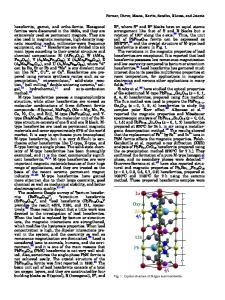Synthesis, structural, dielectric and magnetic properties of hexagonal ferrites
- PDF / 1,799,779 Bytes
- 7 Pages / 595.276 x 790.866 pts Page_size
- 77 Downloads / 399 Views
Synthesis, structural, dielectric and magnetic properties of hexagonal ferrites Shabana Munir1 · Ishtiaq Ahmad1 · A. Laref2 · Hafiz Muhammad Tahir Farid1 Received: 20 April 2020 / Accepted: 15 July 2020 © Springer-Verlag GmbH Germany, part of Springer Nature 2020
Abstract Neodymium-substituted strontium hexa-ferrites Sr0.5-xNdxCo0.5Al0.5Fe11.5O19 (x = 0.0, 0.01, 0.03, 0.05) were synthesized by applying the Sol–gel scheme. The samples were characterized via X-ray diffraction, vibrating sample magnetometer and scanning electron microscopy. The XRD results exposed that the structure was a hexagonal type with some extra peaks and c/a ratio was less than 3.98 which confirmed the M-type hexagonal structure. From VSM results, it was perceived that saturation magnetization enlarged up to 0.01 then dropped with Nd concentration while the coercivity decreased up to 0.01 and then high by the substitution of Nd. SEM showed that grains were platelet-like and grain growth decreased with Nd concentration. Electrical properties were measured and it was observed that AC resistivity dwindled with rising temperature which showed that the material was like a semiconductor. These ferrites may be suitable for perpendicular recording media. Keywords Ferrites · Magnetization · Resistivity · Activation energy · SEM
1 Introduction Lanthanides or rare-earth elements are those that have partially engaged “f” electron shell which hold up to 14 electrons. A strong magnetic field is produced when the spin of these electrons must be aligned; therefore, these elements are used by the compact high-strength magnets. Neodymium is the most powerful commercially produced magnets. It has maximum energy ranging from 30 to 52 MGOe and it also has high strength and relatively low cost. The compounds of “Nd” were used in 1927 commercially as glass dyes. They remain a popular additive in glasses. The color of neodymium compounds is due to the N d3+ ion and is often a reddish purple, but it changes with the type of lighting, because of the interaction of the sharp light absorption bands of neodymium with ambient light enriched with the sharp visible emission bands of mercury, trivalent europium or terbium. Some neodymium-doped glasses are used in lasers that emit infrared with wavelengths between 1047 and 1062 nm [1].
The neodymium-based magnets are widely used in computer hard disk and DC motors, high-performance hobby, ear headphones and also used in appliances where strong magnetic field with smaller mass magnet needed. The Nd magnets used in high-power electric motors. Ferrites are composed of iron oxides, chemically metallic elements. Ferrites are categorized into two types: soft and hard ferrites. A lot of readings on the magnetic assets of hexagonal ferrites have been testified, which demonstrate the enhanced microwave, magnetic and structural aspects due to involvement of rare-earth ion [2, 3]. Most of the investigators have analyzed the substitution of La–Co and Nd–Co in M-type systems and investigated their magnetic features of the ferrites [
Data Loading...











